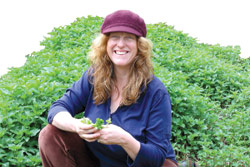Corinna Wood bends over a patch of lemon balm growing in her garden, pinches off some leaves, rubs them between her fingers and sniffs. "You can already feel the mood-enhancing qualities," she exclaims.
It's a sunny September day, and I've asked Wood what plants a novice should plant for her first medicine garden. Director of both Red Moon Herbs and the Southeast Women's Herbal Conference, scheduled for Oct. 2-4 this year, she begins by suggesting I sample what's growing outside her door. We walk into a meandering garden of bright-red nasturtiums spilling across the ground, purple Echinacea blooms waving in the breeze, honeybees buzzing among the flowering sacred basil, late-season jalapeños turning red, and a host of erstwhile weeds that Wood lets grow where they will: The medicine-woman tradition emphasizes using fresh, seasonal plants, she explains.

For example, a homemade poultice containing wild plantain helps treat minor wounds, bee stings and the like, Wood continues, pointing to a few of the plants growing along the fringe of a garden path. Another "weed," wood sorrel, resembles clover but the heart-shaped leaves come in threes, and its flowers are like tiny buttercups. She hands me a few leaves for tasting, mentioning that the wild plant is high in vitamin C. "Sour grass" is another name for it, Wood mentions. And that's the flavor I get: a lettucelike tang that's surprisingly pleasant.
In another garden patch, Wood crouches down and waves her hands through a tangled patch of dark-green peppermint. The nose-opening aroma wafts into the air around us. "With the mints, you're going for the quick aromatics, so just a few fresh sprigs placed in your tea will do the job," she says. The herb can help soothe digestive upsets, and a tea with honey soothes coughs, Wood mentions.
Yarrow's another plant she recommends for a beginner's medicine garden. Fernlike, narrow leaves grow along a slender stem, capped by a flat cluster of small white flowers. Wood hands me a pinch, detailing how its antibacterial properties make it useful for a fresh poultice or a healing oil. Its astringency puckers my mouth a bit.
I notice a line of plants with foot-long, broad leaves that drape over like a big green mop head turned upside-down. For once, she doesn't ask me to chew any, since internal use of this traditional plant is forbidden by the FDA. It's comfrey, nonetheless useful, says Wood: It's an ingredient in Red Moon's "Magic Massage Oil," as well as a healing salve in which it's combined with cold-pressed olive oil, beeswax and plantain. Comfrey also makes for an excellent green manure, tossed into mulches and compost. And its purple, bell-shaped flowers bring more color to the garden.
Wood includes Echinacea in a beginner's garden. Though it's difficult to grow from seed, young plants are commonly available, its tall stems sport big, daisylike purple flowers in late summer, and as a medicinal, it helps strengthen the immune system.
"You don't have to know hundreds of medicinal plants," says Wood. A dozen or less can teach you a lot about medicinal plants and provide a sort of living medicine chest, says Wood, who has a botany degree and apprenticed with renowned medicine-woman Susun Weed. So far, Wood's short list — lemon balm, peppermint, plantain, wood sorrel, comfrey and Echinacea — provide remedies for a broad range of ailments, from coughs to wounds. For the more adventurous and experienced gardener, motherwort would be the next one Wood would grow.
"Leonurus cardiaca," she says, breaking off a stem and giving me a close-up look. The name alone hints that motherwort is good for the heart, but it's also helpful in soothing menstrual cramps and mood swings, Wood mentions.
I sniff and taste it: bitter, with almost no smell. Wood laughs at the face I make while sampling it. "Motherwort's in the mint family but isn't so aromatic," she says.
"Part of what I do is help people develop a relationship with the plants," says Wood. She also encourages "using the medicines you already have nearby." When I mention an early-summer fight with poison ivy, for example, Wood grabs a yellow-orange flower called jewel weed that's an old-fashioned remedy for the rash. She gently touches what looks like part of the flower, and a little pod pops open.
I catch the sense of childlike wonder Wood's sharing with me, and we could wander the garden for hours, enjoying the plants, sunshine and conversation. But it's time for her to meet her son and get back to the work of running an herb business and preparing for a conference that's doubled in size since its inception five years ago. First, though, she arms my medicine chest with a batch of peppermint that just might survive a late-season transplant.
For more information about the conference, visit www.sewisewomen.com. The event takes place at Camp Rockmount in Black Mountain, Oct. 2-4. Susun Weed, renowned author and a featured presenter at the first-ever conference, returns this year.
You can reach Margaret Williams at mvwilliams@mountainx.com or 251-1333, ext. 152.


Hi,
The medicine woman tradition Emphasizes using fresh, seasonal plants, she explains.ex” a homemade poultice containing wild plantain helps treat minor wounds, bee stings and the like,
Thanks…
Vitamins Supplements